Royal Caribbean Group Bundle
How Does Royal Caribbean Group Navigate the High Seas of Business?
Royal Caribbean Group, a titan in the cruise industry, commands a fleet of over 65 ships, charting courses to approximately 1,000 destinations worldwide. Its influence is undeniable, shaping industry trends with innovative ship designs and diverse itineraries. In 2023, the Royal Caribbean Group SWOT Analysis highlighted the company's robust performance, with record-breaking revenue exceeding $14 billion.
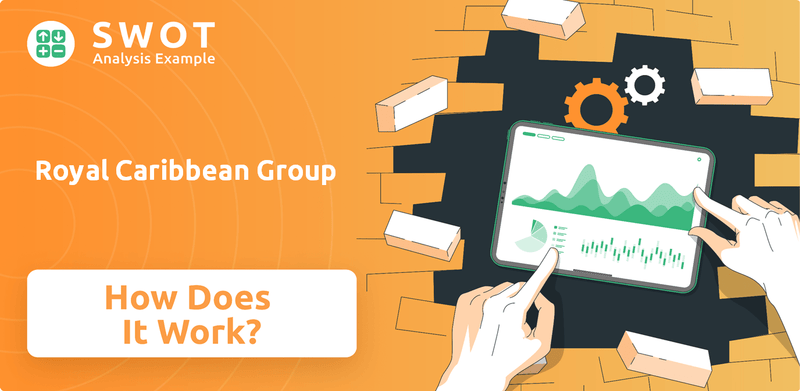
This deep dive into the Royal Caribbean Group explores its intricate business model, revealing how this cruise company generates revenue and maintains its position as a leader. Understanding the operational strategies of Royal Caribbean is essential for anyone interested in the Cruise Industry, from investors to travel enthusiasts, and offers insights into the complexities of large-scale hospitality.
What Are the Key Operations Driving Royal Caribbean Group’s Success?
Royal Caribbean Group, a leading cruise company, generates value through its cruise vacation offerings, catering to a global customer base. The core product is multi-day cruise itineraries, encompassing accommodation, dining, entertainment, and transportation to various destinations. The company serves diverse customer segments, from families on Royal Caribbean International to luxury travelers on Silversea Cruises.
The operational processes are extensive and complex, involving itinerary planning, ship design, and construction. They also include sourcing provisions, onboard hospitality management, entertainment production, and shore excursion coordination. Logistics are crucial for timely provisioning and efficient passenger handling. Technology enhances the guest experience, from online booking to advanced navigational systems.
Sales channels include direct bookings and a network of travel advisors. Customer service is maintained pre-cruise and onboard to address guest needs. The company's commitment to innovation in ship design and onboard experiences, such as surf simulators and robotic bars, differentiates it from competitors. This, combined with economies of scale, translates into diverse entertainment, dining choices, and unique destinations for customers.
Royal Caribbean Group's primary offerings are multi-day cruise vacations. These cruises include accommodations, dining, entertainment, and transportation to various destinations. The company operates several cruise lines, including Royal Caribbean International, Celebrity Cruises, and Silversea Cruises, each targeting different customer segments.
Operational processes involve meticulous itinerary planning, ship design and construction, and sourcing provisions. Onboard hospitality management, entertainment production, and shore excursion coordination are also crucial. Logistics, including timely provisioning and efficient passenger handling, are paramount. Technology plays a key role in enhancing the guest experience.
Sales channels include direct bookings through websites and call centers, and a vast network of travel advisors. Customer service is maintained both pre-cruise and onboard to address guest needs. The distribution network leverages brand recognition and travel agent relationships to reach customers worldwide.
Royal Caribbean Group distinguishes itself through innovation in ship design and onboard experiences. This includes features like surf simulators and robotic bars. Economies of scale from operating a large fleet translate into diverse entertainment, dining choices, and access to unique destinations, differentiating it from competitors.
The operational success of Royal Caribbean Group hinges on several key aspects. These include efficient supply chain management, strategic partnerships, and a robust distribution network. The company's commitment to innovation and customer satisfaction further enhances its operational efficiency and market position. For more insights, consider reading about the Marketing Strategy of Royal Caribbean Group.
- Supply Chain: Relies on a global network of suppliers for food, beverages, and maintenance parts.
- Partnerships: Essential partnerships with port authorities and local tour operators.
- Distribution: Leverages brand recognition and travel agent relationships.
- Innovation: Continuous introduction of new features and experiences.
Royal Caribbean Group SWOT Analysis
- Complete SWOT Breakdown
- Fully Customizable
- Editable in Excel & Word
- Professional Formatting
- Investor-Ready Format
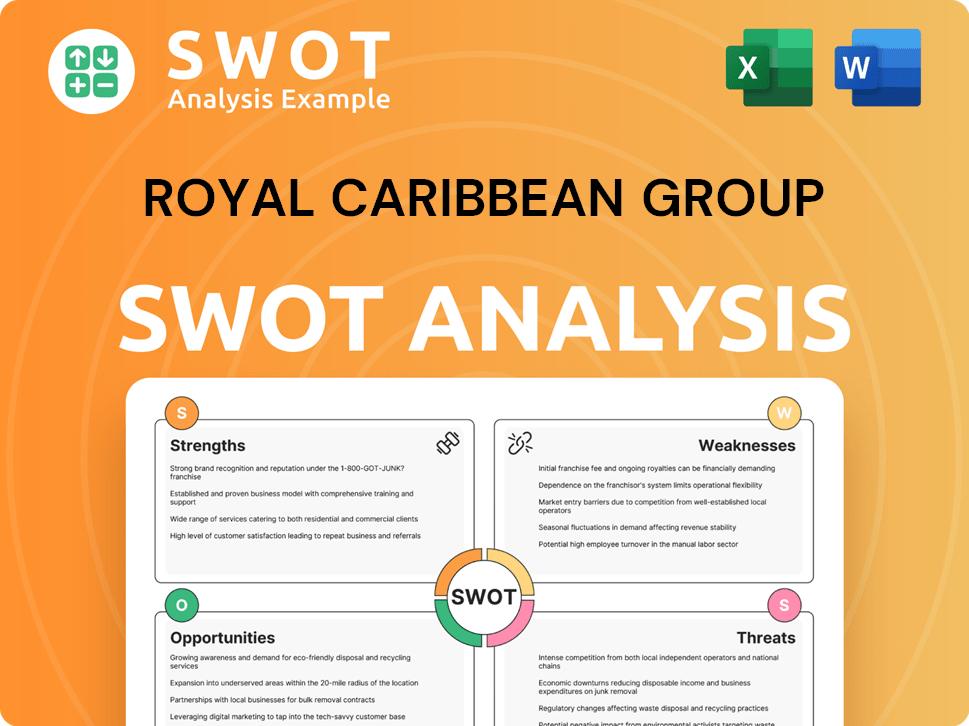
How Does Royal Caribbean Group Make Money?
The primary revenue streams for Royal Caribbean Group (RCCL) are ticket revenue and onboard revenue. Ticket revenue comes from cruise fares, while onboard revenue includes spending on various services and products. This dual approach allows the cruise company to capture a broad range of consumer spending.
In fiscal year 2023, Royal Caribbean Group reported total revenues exceeding $14 billion, demonstrating its significant market presence. The company's financial performance is closely watched within the cruise industry, and its revenue streams are key indicators of its overall health and success.
Royal Caribbean Group employs several innovative monetization strategies to maximize revenue. These include bundled services, tiered pricing, and cross-selling opportunities, all designed to enhance the guest experience and increase profitability.
Royal Caribbean Group utilizes several strategies to boost revenue and enhance guest spending. These methods are crucial for the financial success of the cruise company and contribute to its overall market position. For more detailed information about the company's structure, you can read about Owners & Shareholders of Royal Caribbean Group.
- Bundled Services: Packages that combine drinks, internet, and specialty dining at a discounted rate.
- Tiered Pricing: Offering various cabin and experience options to cater to different budgets.
- Cross-Selling: Promoting onboard amenities, shore excursions, and future cruise credits before the cruise.
- Loyalty Programs: Incentivizing repeat bookings to ensure a steady revenue stream.
- Luxury Brand Acquisitions: Expanding into higher-yield segments through brands like Silversea Cruises.
Royal Caribbean Group PESTLE Analysis
- Covers All 6 PESTLE Categories
- No Research Needed – Save Hours of Work
- Built by Experts, Trusted by Consultants
- Instant Download, Ready to Use
- 100% Editable, Fully Customizable
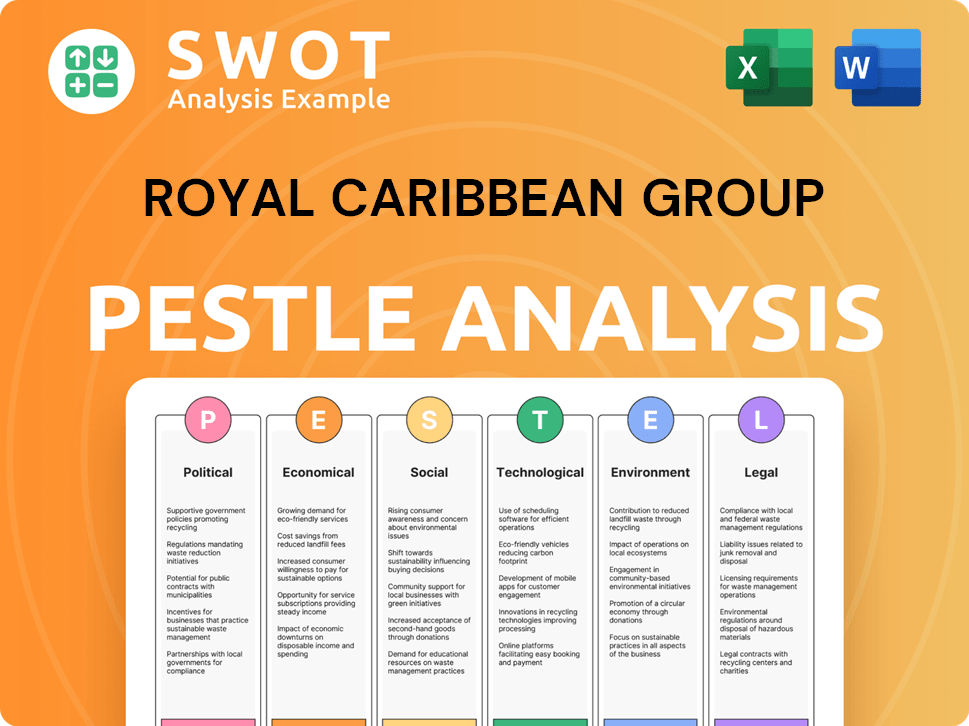
Which Strategic Decisions Have Shaped Royal Caribbean Group’s Business Model?
The operational and financial trajectory of Royal Caribbean Group has been significantly shaped by strategic decisions and key milestones. The introduction of innovative ship classes, such as the Oasis class, which debuted in 2009, marked a pivotal moment. These ships featured unprecedented onboard amenities and significantly increased passenger capacity, setting a new standard in the cruise industry. This strategy of building larger, more amenity-rich ships has been a cornerstone of Royal Caribbean International's growth.
Strategic acquisitions have also played a crucial role in Royal Caribbean Group's expansion. The acquisitions of Celebrity Cruises and Silversea Cruises allowed the company to diversify its brand portfolio, catering to a broader range of market segments, from premium to ultra-luxury cruising. This diversification strategy has strengthened the company's market position and resilience. The company's ability to adapt and recover from the COVID-19 pandemic, achieving record revenues in 2023 and early 2024, demonstrates its robust recovery and adaptive capacity.
The cruise company has faced considerable operational and market challenges, most notably the disruption caused by the COVID-19 pandemic. This period saw a complete halt to global cruise operations, leading to significant financial losses and operational restructuring. Royal Caribbean Group responded by implementing stringent health and safety protocols, collaborating with health authorities, and focusing on cost management and liquidity preservation.
The launch of the Oasis class ships in 2009, with Oasis of the Seas, marked a significant milestone, increasing passenger capacity and onboard amenities. The acquisitions of Celebrity Cruises and Silversea Cruises expanded the brand portfolio. These strategic moves helped the company to cater to a broader market.
Diversification through acquisitions, such as Celebrity Cruises and Silversea Cruises, has been a key strategic move. Focusing on larger, amenity-rich ships has also been a core strategy. The company's response to the COVID-19 pandemic, including health protocols and cost management, was also a key move.
Brand strength, technology leadership, economies of scale, and global partnerships are key competitive advantages. The company leverages digital platforms for seamless travel planning and onboard services. The company benefits from an extensive global ecosystem of port relationships, travel agent networks, and loyal customer bases across its brands.
Royal Caribbean Group is adapting to new trends, such as the increasing demand for sustainable travel, by investing in cleaner energy technologies and responsible tourism practices. It also leverages technological shifts to enhance guest experiences and operational efficiency. This helps the company to sustain its business model in a dynamic market.
Royal Caribbean Group's competitive advantages include brand strength, technology leadership, and economies of scale. Its extensive global ecosystem of port relationships and loyal customer bases further enhances its position. The company's ability to innovate and adapt to market changes is crucial for its long-term success.
- Brand Strength: One of the most recognized names in leisure travel.
- Technology Leadership: Digital platforms for travel planning and onboard services.
- Economies of Scale: Cost efficiencies in procurement and operations.
- Global Ecosystem: Extensive port relationships and travel agent networks.
In 2023, Royal Caribbean Group reported record revenues, demonstrating a strong recovery from the pandemic. For the full year 2023, the company reported total revenues of approximately $9.5 billion, with a net yield of $136.53. The company's focus on operational efficiency and strategic investments has allowed it to navigate challenges and capitalize on opportunities in the Competitors Landscape of Royal Caribbean Group. The company continues to adapt to new trends, such as the increasing demand for sustainable travel, by investing in cleaner energy technologies and responsible tourism practices, and leveraging technological shifts to enhance guest experiences and operational efficiency.
Royal Caribbean Group Business Model Canvas
- Complete 9-Block Business Model Canvas
- Effortlessly Communicate Your Business Strategy
- Investor-Ready BMC Format
- 100% Editable and Customizable
- Clear and Structured Layout
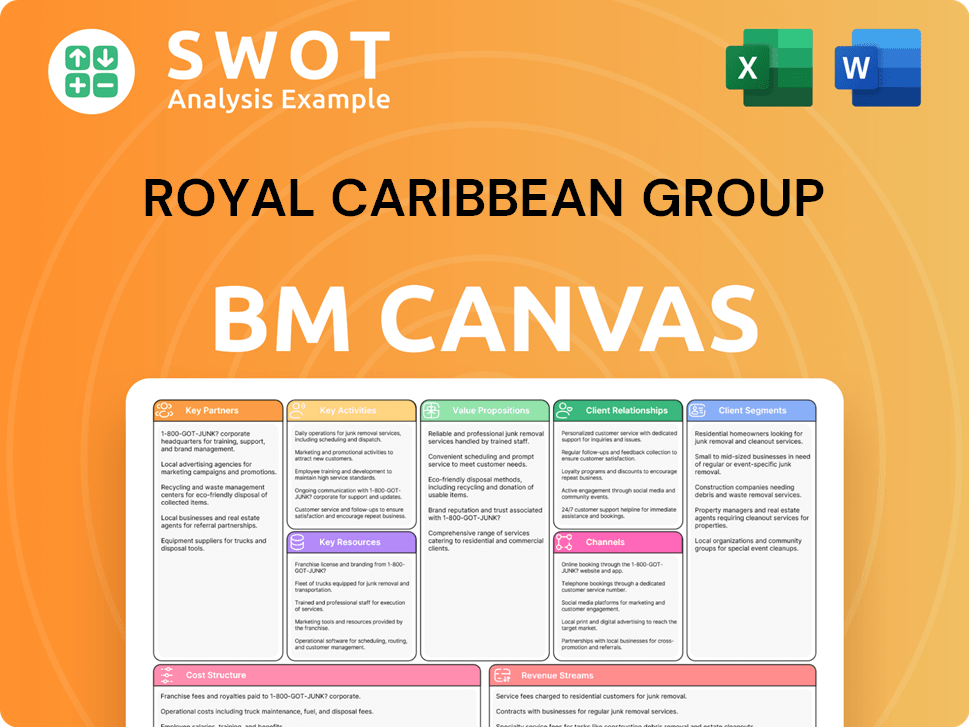
How Is Royal Caribbean Group Positioning Itself for Continued Success?
Royal Caribbean Group, a prominent player in the cruise industry, holds a significant market position, competing with major Cruise Lines like Carnival Corporation and Norwegian Cruise Line Holdings. The company's diverse portfolio of brands caters to various customer preferences, supporting a strong global presence and customer loyalty through robust programs. It operates across multiple continents, focusing on key markets such as North America, Europe, and Asia.
Despite its strong market position, Royal Caribbean faces several risks. These include regulatory changes, particularly concerning environmental regulations and health protocols, which can impact operations. Geopolitical events, economic downturns, and changing consumer preferences also influence demand. Fluctuations in fuel prices further represent a significant operational risk.
Royal Caribbean Group is a leading Cruise Company, recognized for its extensive global reach and diverse brand portfolio. The company's market share is substantial, supported by strong customer loyalty programs. Its operations span across major cruise markets, ensuring a broad customer base.
The company faces risks from regulatory changes, particularly concerning environmental and health protocols. Geopolitical events and economic downturns can significantly affect demand. Fluctuations in fuel prices pose a considerable operational risk, impacting profitability.
Royal Caribbean Group is focusing on strategic initiatives to sustain revenue growth, including investment in new ships and sustainable cruising practices. The company is prioritizing yield management to maximize revenue and expand into emerging markets. The future appears positive, with strong booking trends.
The company is investing in innovative ships, such as the Icon Class, to attract a broad customer base. It aims to reduce its environmental footprint through sustainable cruising practices. Yield management and expansion into new markets are key priorities.
Royal Caribbean Group is committed to enhancing guest experiences and driving financial performance through strategic initiatives. The company's focus includes optimizing pricing strategies and expanding into emerging markets to boost revenue. For detailed insights into the company's growth strategy, refer to the Growth Strategy of Royal Caribbean Group.
- Continued investment in new ships and onboard experiences remains a priority, with the Icon Class ships being a key example.
- Emphasis on sustainable cruising practices to align with growing consumer demand for responsible tourism.
- Focus on yield management to optimize pricing and maximize revenue per guest.
- Expansion into emerging markets to broaden the customer base and increase market share.
Royal Caribbean Group Porter's Five Forces Analysis
- Covers All 5 Competitive Forces in Detail
- Structured for Consultants, Students, and Founders
- 100% Editable in Microsoft Word & Excel
- Instant Digital Download – Use Immediately
- Compatible with Mac & PC – Fully Unlocked
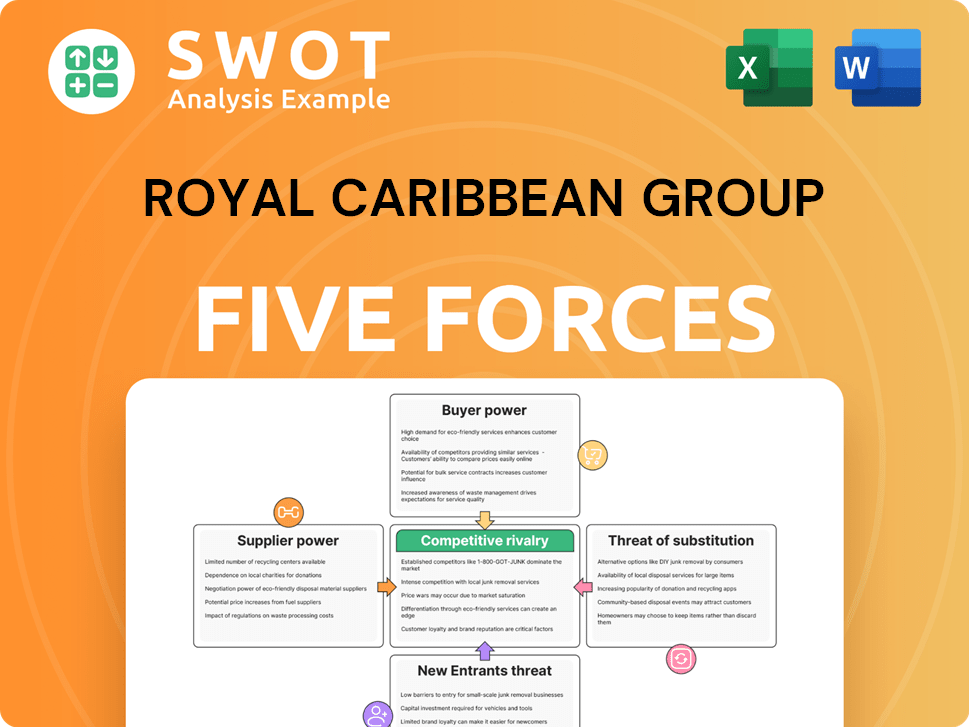
Related Blogs
- What are Mission Vision & Core Values of Royal Caribbean Group Company?
- What is Competitive Landscape of Royal Caribbean Group Company?
- What is Growth Strategy and Future Prospects of Royal Caribbean Group Company?
- What is Sales and Marketing Strategy of Royal Caribbean Group Company?
- What is Brief History of Royal Caribbean Group Company?
- Who Owns Royal Caribbean Group Company?
- What is Customer Demographics and Target Market of Royal Caribbean Group Company?
Disclaimer
All information, articles, and product details provided on this website are for general informational and educational purposes only. We do not claim any ownership over, nor do we intend to infringe upon, any trademarks, copyrights, logos, brand names, or other intellectual property mentioned or depicted on this site. Such intellectual property remains the property of its respective owners, and any references here are made solely for identification or informational purposes, without implying any affiliation, endorsement, or partnership.
We make no representations or warranties, express or implied, regarding the accuracy, completeness, or suitability of any content or products presented. Nothing on this website should be construed as legal, tax, investment, financial, medical, or other professional advice. In addition, no part of this site—including articles or product references—constitutes a solicitation, recommendation, endorsement, advertisement, or offer to buy or sell any securities, franchises, or other financial instruments, particularly in jurisdictions where such activity would be unlawful.
All content is of a general nature and may not address the specific circumstances of any individual or entity. It is not a substitute for professional advice or services. Any actions you take based on the information provided here are strictly at your own risk. You accept full responsibility for any decisions or outcomes arising from your use of this website and agree to release us from any liability in connection with your use of, or reliance upon, the content or products found herein.